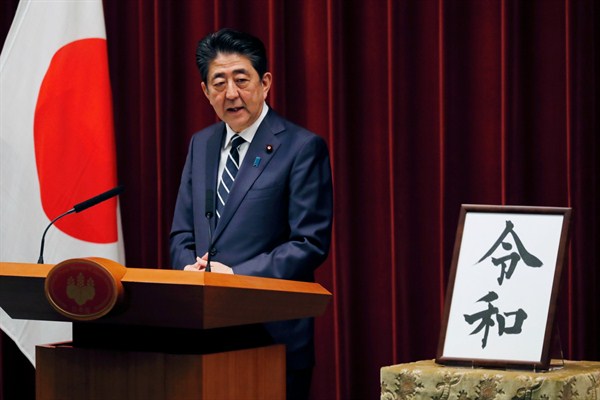Later this month, Japan’s Emperor Akihito will become the first monarch to abdicate in the country’s modern history. When he does, the curtains will fall on Japan’s current imperial era, known as “Heisei,” which began in 1989 when Akihito became emperor. His son, Crown Prince Naruhito, will accede to the throne on May 1, opening a new chapter in Japanese history. In a much-anticipated moment earlier this week, the government unveiled the name of that new era: “Reiwa.”
Japan’s unique imperial calendar scheme dates back to the 7th century, and ever since the 1860s, the reign of every Japanese emperor has coincided with a distinctively named epoch. Whereas the names of previous reigns of Japanese emperors came from classical Chinese literature, Reiwa is derived from a passage in the Manyoshu, the oldest existing collection of Japanese poetry, believed to have been compiled around 1,200 years ago. It describes the “auspicious month” when winter fades into spring. In typically florid remarks following the announcement, Japanese Prime Minister Shinzo Abe said that the Manyoshu “expresses our nation’s rich culture, which we should take pride in,” and that the name Reiwa was chosen in the hopes that “all Japanese will be able to make their own blossoms come into full bloom, together with their hopes for tomorrow.”
The process for naming imperial eras, which are known in Japan as gengo, involves soliciting ideas and feedback from outside experts, whose identities are kept secret. The final decision has both far-reaching practical implications and important symbolic meaning in Japan. Gengo are widely used alongside the Gregorian calendar, so official documents must be reprinted and software updated. But more importantly, they serve as cultural benchmarks—or at least, as signifiers of how most Japanese would prefer to see these periods. Showa, the era under Emperor Hirohito that lasted from 1926 until 1989, is widely used as shorthand by many Japanese to harken back to their country’s postwar economic boom—while often overlooking Japan’s military rule, invasions and occupations of neighboring countries, and entry into World War II.

